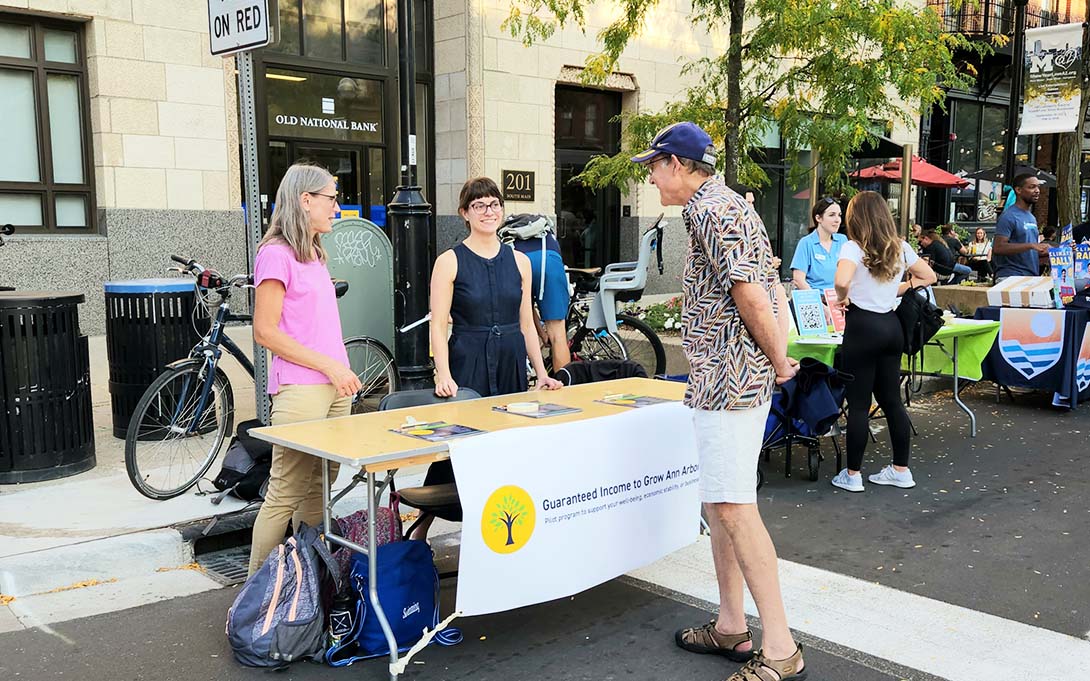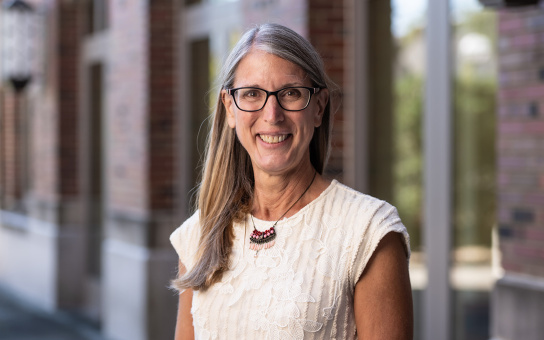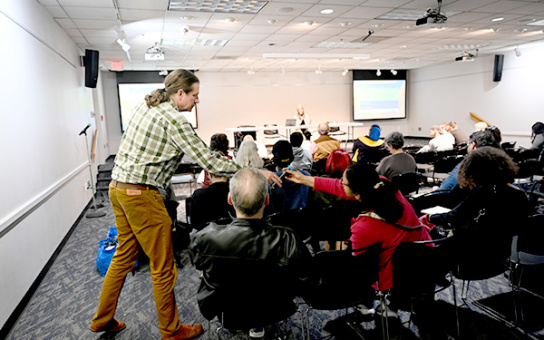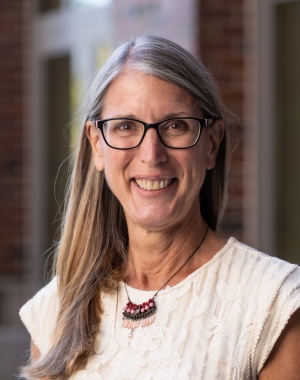
U-M researchers play role in reimagining social safety net in Ann Arbor and beyond
For the nearly three decades Kristin Seefeldt (MPP ’96, PhD ’10) has lived and worked in Ann Arbor, her professional life studying and teaching about poverty issues at the University of Michigan had little overlap with her home life on the city’s north side.
But that changed this past summer when the Ann Arbor City Council selected a proposal spearheaded by Seefeldt for its two-year guaranteed income pilot—the first guaranteed income program in Michigan.
“It’s … felt very special to be able to do something that contributes to people who are my fellow residents, maybe my neighbors. You know, that’s just not an opportunity I’ve had before,” said Seefeldt, whose prior research focused on the economic well-being of Detroit residents.

Seefeldt is an associate professor of social work and public policy and the associate director of Poverty Solutions, a university-wide research initiative housed at the Gerald R. Ford School of Public Policy. She developed the guaranteed income proposal with co-Principal Investigators William Lopez, a clinical assistant professor of health behavior and health education and faculty associate in the Latina/o Studies Program, and Rebeccah Sokol, an assistant professor of social work, along with staff at Poverty Solutions.
Now dubbed Guaranteed Income to Grow Ann Arbor (GIG A2), the pilot will provide monthly payments of $528 for two years to 100 people. GIG A2 takes a novel approach to no-strings attached cash assistance that focuses on entrepreneurs, self-employed people, and gig workers with low incomes, and the study will assess how the cash affects people’s well-being and economic stability.
While guaranteed income programs are popping up across the U.S., it took a pandemic, a breakthrough in town-gown relations, and a willingness to reimagine the local social safety net in order to bring guaranteed income to Ann Arbor.
A window into local policymaking
Following the darkest days of the pandemic, Ann Arbor was awarded $24.2 million in federal American Rescue Plan Act (ARPA) funds to assist with pandemic recovery. City Council identified three broad uses for the money: address municipal revenue shortfalls, invest in infrastructure, and support social services.
“I wanted to see that relief for our communities that were hurt most by the pandemic,” said City Councilmember Linh Song, who championed the guaranteed income proposal. Her interest in basic income programs started even before she took her city council seat in November 2020.
To build support for the idea, Song gathered information on expiring pandemic-era assistance and how other cities spent their ARPA funds. Basic income was one of 13 options in a spending plan the city presented to residents for feedback, and city council ultimately allocated $1.6 million in APRA funds to a pilot.

“I know there was some pushback about it being a pilot, but this is as good a time as any to figure out what poverty looks like in our community and to encourage folks to really advocate for something,” Song said.
The city wants the guaranteed income pilot to contribute to the collective understanding of the effectiveness of cash assistance and inform other guaranteed income efforts across the country. After reviewing proposals for the design, implementation, and study of the pilot, city staff recommended the approach developed by U-M researchers. Council approved it in June— with a final policymaking twist. While the original proposal said anyone who lived, worked, worshiped, or studied in Ann Arbor and met the income-based criteria would qualify for the pilot, city council limited eligibility to Ann Arbor residents. Song said the desire to keep tax dollars within city borders had come up in prior council discussions.
“I felt like it was really limiting in how we think about poverty and who is poor and how we think about who needs assistance,” she said. “So it was disappointing, but it wasn’t surprising.”
Town-gown relations added complexity to garnering support for the pilot. Seefeldt noted the many collaborations between the university and city and acknowledged some Ann Arbor residents take issue with the university’s influence in town. GIG A2 is one of the more prominent partnerships between U-M and the city government, and Seefeldt and Song are optimistic it will be a positive experience.
“It’s not just an academic exercise, and it’s not just a line in our budget,” Song said. “This is coming together as a shared interest in community well-being.”

Designing a new approach to public assistance
Ann Arbor may not be an obvious candidate for a guaranteed income pilot, given the area’s relatively high median income. Still, nearly 1 in 4 residents live in poverty, and the city’s higher cost of living—driven largely by housing costs—is unaffordable for low-wage workers."
“People really need cash,” Seefeldt said. “Even if they’re receiving lots of different forms of public assistance, it’s not enough. And it’s certainly not enough in a high cost of living city like Ann Arbor, which is why we also think that there are lots of folks out there engaged in entrepreneurial activities. You just kind of have to, because low-wage earnings plus public benefits are not going to keep you afloat for very long.”
In working through the pilot design and launch this fall, Seefeldt said the research team had to fight against inadvertently replicating the burdensome bureaucracy embedded in the U.S. welfare system. While seeking to respect applicants’ autonomy and dignity, the research team also needed to perform due diligence to verify the public funds would be spent as intended.
The result was a relatively short application that asked for three documents to verify the person’s identity, residency, and income— the main criteria to qualify for GIG A2. Because the pilot is aimed at entrepreneurs—broadly defined— applicants also answered questions about the type of self-employed, freelance, or gig work they do.
To make the application process easier, the research team—which included Poverty Solutions staff and 24 student research assistants working alongside Seefeldt, Lopez, and Sokol—responded to people’s questions via email, text, and phone calls as well as offering in-person assistance during the two-week application period in October.
Another consideration was whether the extra income would disqualify people for other types of public assistance, resulting in a net loss in income that could extend beyond the two-year pilot. To minimize any negative impact caused by participating in the guaranteed income pilot, the research team asked the Michigan Department of Health and Human Services to make arrangements so the extra income would not count against other benefits. The Ann Arbor Housing Commission granted a similar request for housing benefits.
“When I teach a social welfare policy class, I always talk about the safety net in the United States as being a patchwork that’s loosely bound together but also has a lot of holes. And this really reinforced that metaphor for me,” Seefeldt said. “There’s no way to get waivers for every single program all at once because of the disparate rules across different programs.”
This fall, just over 1,000 people applied for GIG A2. In the coming months, 100 eligible applicants will be randomly selected to receive the monthly cash payments and another 100 randomly selected eligible applicants will participate in the research study without the payments. Payments will start in January 2024. Study participants will be invited to take surveys and participate in interviews over the course of the pilot that ask about how they use the guaranteed income money; their experiences affording food, housing, and child care; and their health and well-being.
By Lauren Slagter
More in State & Hill
Below, find the full, formatted fall 2023 edition of State & Hill. Click here to return to the fall 2023 S&H homepage.

